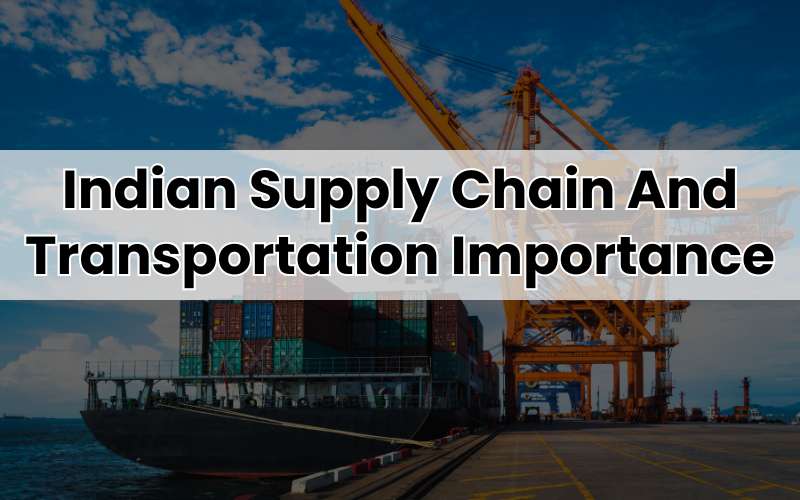Introduction
The Indian supply chain and transportation network form the backbone of the country’s economy. As one of the fastest-growing economies globally, India’s logistics infrastructure plays a pivotal role in facilitating trade, manufacturing, and distribution activities. In this article, we delve into the significance of the Indian supply chain, the challenges it faces, the role of transportation, technological advancements, government initiatives, and future trends.
Understanding Indian Supply Chain
Definition of Supply Chain
A supply chain encompasses all processes involved in the production and distribution of goods and services, from raw material sourcing to the delivery of the final product to consumers. In India, the supply chain involves various stakeholders, including manufacturers, suppliers, logistics providers, wholesalers, retailers, and end consumers.
Components of the Supply Chain
The Indian supply chain consists of several interconnected components, such as procurement, production, inventory management, warehousing, transportation, and distribution. Each element plays a crucial role in ensuring the smooth flow of goods across the supply chain network.
Importance of Supply Chain in India
The efficient functioning of the supply chain is vital for driving economic growth, enhancing competitiveness, reducing costs, and improving customer satisfaction. In India, a well-optimized supply chain can enable businesses to capitalize on market opportunities, streamline operations, and meet evolving consumer demands effectively.
Challenges in Indian Supply Chain
Infrastructure Constraints
India’s supply chain infrastructure faces significant challenges, including inadequate transportation networks, congested ports, outdated warehousing facilities, and poor last-mile connectivity. These infrastructure bottlenecks often result in delays, higher logistics costs, and inefficiencies across the supply chain.
Regulatory Challenges
Complex regulations, bureaucratic hurdles, and inconsistencies in policies pose significant challenges to the Indian supply chain ecosystem. Issues such as multiple taxation systems, compliance requirements, and regulatory bottlenecks hinder the seamless movement of goods and increase operational complexities for businesses.
Operational Issues
Inefficient processes, fragmented logistics operations, lack of standardization, and manual paperwork contribute to operational inefficiencies in the Indian supply chain. Poor inventory management, inaccurate demand forecasting, and suboptimal routing decisions further exacerbate these challenges, leading to delays and increased costs.
Transportation in Indian Supply Chain
Modes of Transportation
Transportation plays a critical role in the Indian supply chain, facilitating the movement of goods across vast distances and diverse terrains. The country relies on various modes of transportation, including road, rail, maritime, and air, each offering distinct advantages and serving specific logistics requirements.
Road Transportation
Road transportation is the backbone of India’s logistics network, accounting for the majority of freight movement. The extensive road network connects remote regions to major cities and industrial hubs, enabling the seamless distribution of goods across the country. However, challenges such as traffic congestion, poor road conditions, and regulatory issues impact the efficiency of road transport.
Rail Transportation
Rail transportation is a cost-effective and environmentally sustainable mode of freight movement in India. The Indian Railways, one of the world’s largest rail networks, plays a crucial role in transporting bulk commodities, such as coal, minerals, and agricultural produce, over long distances. However, limited connectivity, capacity constraints, and operational inefficiencies pose challenges to rail freight logistics.
Maritime Transportation
Maritime transportation is essential for facilitating international trade and connecting India to global markets. Major ports along the coastline handle a significant portion of India’s external trade, handling diverse cargo types, including containers, bulk cargo, and liquid bulk. However, infrastructure constraints, port congestion, and regulatory bottlenecks affect the efficiency of maritime logistics operations.
Air Transportation
Air transportation is primarily used for transporting high-value and time-sensitive goods, such as perishable items, electronics, and pharmaceuticals. India’s aviation sector has witnessed significant growth in recent years, with airports expanding their cargo handling capacities to meet rising demand. However, limited airport infrastructure, high operating costs, and regulatory challenges pose obstacles to the development of air cargo logistics.
Role of Technology in Indian Supply Chain
Automation and Digitization**
Automation and digitization are transforming the Indian supply chain landscape, enhancing efficiency, transparency, and agility. Technologies such as warehouse automation, robotics, and IoT-enabled devices streamline operations, reduce manual errors, and optimize resource utilization. Digital platforms and supply chain management software enable real-time tracking, inventory visibility, and predictive analytics, empowering businesses to make data-driven decisions and improve customer service.
IoT and Supply Chain Management
The Internet of Things (IoT) is revolutionizing supply chain management by enabling seamless connectivity and data exchange across the entire supply chain ecosystem. IoT devices, such as sensors, RFID tags, and GPS trackers, provide real-time insights into asset location, condition, and performance. This visibility enables proactive maintenance, route optimization, and demand forecasting, leading to enhanced operational efficiency and cost savings.
Data Analytics for Optimization
Data analytics plays a crucial role in optimizing the Indian supply chain by unlocking actionable insights from vast amounts of data generated across various touchpoints. Advanced analytics techniques, such as machine learning and predictive modeling, enable businesses to forecast demand, optimize inventory levels, and identify process bottlenecks. By leveraging data analytics, companies can improve supply chain resilience, responsiveness, and decision-making capabilities.
Government Initiatives and Policies
Make in India Campaign
The Make in India campaign aims to promote domestic manufacturing, attract foreign investment, and boost the country’s industrial growth. By encouraging local production, the initiative seeks to reduce dependence on imports, create employment opportunities, and strengthen India’s position as a global manufacturing hub. The Make in India initiative has led to several policy reforms, infrastructure investments, and incentives for businesses across various sectors.
GST Implementation
The implementation of the Goods and Services Tax (GST) has streamlined tax compliance, reduced logistics costs, and simplified interstate trade in India. The unified tax regime has replaced multiple indirect taxes with a single tax system, eliminating tax cascading and reducing bureaucratic hurdles. GST has facilitated smoother movement of goods across state borders, leading to improved supply chain efficiency and cost savings for businesses.
National Logistics Policy
The National Logistics Policy aims to transform India’s logistics sector into a competitive and efficient ecosystem. The policy focuses on enhancing infrastructure development, digitization, skill development, and regulatory reforms to reduce logistics costs and improve supply chain efficiency. By promoting multimodal connectivity, standardizing procedures, and implementing best practices, the National Logistics Policy aims to make India a global logistics hub.
Future Trends and Opportunities
Integration of AI and Machine Learning
Artificial Intelligence (AI) and Machine Learning (ML) technologies are poised to revolutionize the Indian supply chain industry. AI-powered predictive analytics, demand forecasting, and route optimization algorithms can enhance supply chain visibility, agility, and resilience. ML algorithms can analyze vast amounts of data to identify patterns, optimize inventory levels, and mitigate risks, enabling businesses to stay competitive in dynamic market environments.
Sustainable Supply Chain Practices
Sustainability is becoming increasingly important in the Indian supply chain, driven by environmental concerns, regulatory pressures, and consumer preferences. Adopting sustainable practices, such as green logistics, renewable energy adoption, and waste reduction, can help businesses minimize their environmental footprint, enhance brand reputation, and comply with regulatory requirements. Sustainable supply chain initiatives also create opportunities for cost savings, resource efficiency, and long-term resilience.
E-commerce Growth Impact
The rapid growth of e-commerce is reshaping the Indian supply chain landscape, driving demand for faster, more flexible logistics solutions. With the rise of online shopping platforms, there is a growing need for efficient warehousing, last-mile delivery, and reverse logistics services. E-commerce companies are leveraging technology, data analytics, and automation to optimize their supply chain operations, improve customer experience, and gain a competitive edge in the market.
Conclusion
The Indian supply chain and transportation network play a pivotal role in driving economic growth, fostering trade, and enabling businesses to reach global markets. Despite facing challenges such as infrastructure constraints, regulatory complexities, and operational inefficiencies, the Indian supply chain industry is evolving rapidly, driven by technological advancements, government initiatives, and changing consumer preferences. By embracing innovation, collaboration, and sustainability, India can unlock new opportunities, enhance competitiveness, and build a resilient supply chain ecosystem for the future.
FAQs
What are the major challenges faced by the Indian supply chain?
The Indian supply chain faces challenges such as infrastructure constraints, regulatory complexities. Operational inefficiencies, which impact efficiency and increase costs for businesses.
How does transportation contribute to the efficiency of the Indian supply chain?
Transportation plays a crucial role in the Indian supply chain by facilitating the movement of goods. Across vast distances and diverse terrains, connecting production centers to markets and ports.
What role does technology play in optimizing the Indian supply chain?
Technology enables automation, digitization, and data analytics, enhancing supply chain visibility, agility, and efficiency. Enabling businesses to make informed decisions and improve operational performance.
What are some key government initiatives aimed at improving the Indian supply chain?
Government initiatives such as Make in India, GST, and the National Logistics Policy focus on infrastructure dev. Regulatory reforms, and promoting domestic manufacturing to strengthen the Indian supply chain ecosystem.
What are the future prospects for the Indian supply chain industry?
The Indian supply chain industry is poised for growth, driven by trends such as the integration of AI. Sustainable practices, and the impact of e-commerce growth, offering new opportunities for innovation and competitiveness.
Know More About Author Prince Khanuja Founder Of Khanuja Group




